So perhaps you’ve just begun setting up your new hot tub and are thinking about sanitizer. You have a choice between chlorine and bromine sanitizers and you’re not sure which to use. In this article, we’ll give you a detailed description of both so that you can make an informed decision.
Bromine is used more often for hot tubs than chlorine and it is most suitable for indoor hot tubs or spas. Bromine is gentler on the skin and respiratory system. Chlorine is the best choice for outdoor hot tubs as it is stabilized. Chlorine is cheaper than bromine.
It all comes down to personal preference. Chlorine and bromine both have their advantages and disadvantages, depending on different factors, so it depends on where your priorities lie.
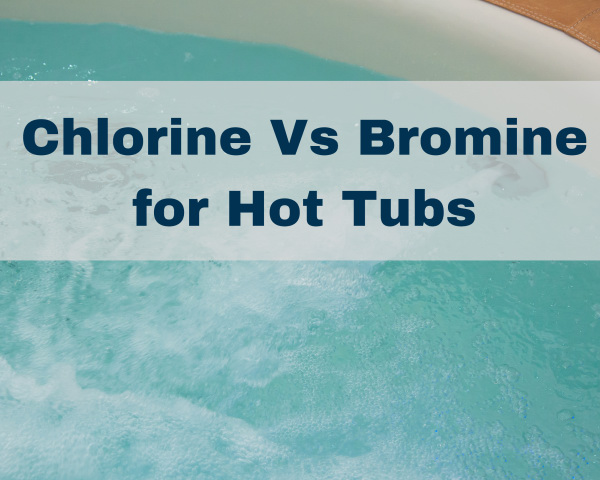
Having a clear understanding of how these two sanitizers work is essential to keeping your hot tub clean and safe for use, so let’s go over them individually first before moving on to compare them.
Article Contents
What is Chlorine?
Chlorine sanitizer works as an oxidizer that can invade contaminants and destroy them from the inside. As chlorine is dissipated and used up, it leaves behind chloramines, as a waste product. This is what causes that familiar smell we’re used to.
Chloramines reduce the effectiveness of chlorine. It’s essential to add chlorine regularly to keep the chloramines at a stable level.
Dichlor is typically the type of chlorine used in hot tubs, as it is very stable and doesn’t break down easily. Trichlor, on the other hand, is typically used in swimming pools, as using it in hot tubs can lead to it becoming very corrosive and can damage your pool.
Dichlor is a stabilized chlorine and contains cyanuric acid. The cyanuric acid protects the chlorine from breaking down under the sun’s ultraviolet rays.
What is Bromine Sanitizer?
Bromine is more popular than chlorine for use in hot tubs. Unlike chlorine, bromine works as an ionizer, which forces apart the chemical bonds that form contaminants.
Similar to chlorine, bromine also produces its own waste product (known as bromamines) once it has been used up, though this process takes longer than its chlorine counterpart. Like chloramines, bromamines also reduce the effectiveness of its associated sanitizer, though aren’t nearly as pungent as chloramines.
Bromine is very stable in high temperatures.
Chlorine/Bromine Pros and Cons Summarized
Here’s a table of the general pros and cons regarding chlorine and bromine sanitizers, some of which we’ll go into more detail later in the article.
| Sanitizer | Pros | Cons |
| Chlorine | Kills contaminants quicker than bromine Not as susceptible to degradation under UV (when stabilized) Cheaper Results in clearer water | Higher pH than bromine, so overall harder to adjust water chemistry Dissipates quicker than bromine Chloramines decrease the effectiveness of chlorine more than bromamines does to bromine Can be harsh on the body when levels are high, and chloramines can cause breathing problems More usage is needed |
| Bromine | Lower pH than chlorine, so easier to keep the water chemistry balanced Can kill bacteria for a longer period (unless under UV light) Gentler on the skin Requires less usage | Not as reactive as chlorine More bromine than chlorine is needed in order to achieve the same effects Not stable in direct sunlight More expensive It may be harder to wash off after a long soak Water may not be as clean after sanitization as with chlorine usage |
How Are Chlorine and Bromine Different?
Chlorine and bromine differ in several ways ranging from their respective mechanisms, cost, safety, and more. They differ in so many aspects that, besides the fact that they can both be used as sanitizers in granule or tablet form for your hot tub, there’s really not much else that is identical between them.
They Work Differently
For one thing, chlorine and bromine differ in the way that they sanitize the water. While chlorine cleanses the water via oxidation, bromine does it via ionization. Due to the different ways in which they work, chlorine and bromine are best used for killing algae and bacteria respectively.
Bromine is Usually More Stable
Another difference is that because bromine is more stable under high temperatures and has a lower pH, it can remain in the water for a longer period than chlorine. However, remember that this becomes the opposite when bromine is under UV light exposure.
Chlorine is able to be protected with the use of stabilizers (cyanuric acid). There are no products that stabilize bromine, leaving bromine susceptible to burning off in direct sunlight.
However, too many stabilizers in the water is a bad thing. The continual use of dichlor in a hot tub will lead to ever-increasing stabilizer levels. The only way to reduce stabilizer (CYA or cyanuric acid) is to partially drain the water and fill it with fresh water.
The Costs Vary
Bromine is more expensive than chlorine and because it’s not as potent as chlorine, can take longer for it to sanitize the hot tub. Though it may seem like it’s a heftier investment, you should consider the fact that because of how stable bromine is in a hot tub environment, it takes longer for bromine to degrade than chlorine.
Therefore, you’re using less bromine than you would chlorine. In the long run, this can help even out the cost.
Bromine costs roughly $10 per lb (depending on where you buy it). Whereas chlorine (dichlor), is roughly $5 per lb.
Bromine is Safer on the Body
Compared to chlorine, bromine is both less irritating on the skin and less odorous. Its waste products are also less potent than those of chlorine. Some people complain that hot tubs that use chlorine give them breathing difficulties and even asthma attacks.
If you or someone you know has sensitive skin or has upper respiratory tract difficulties, bromine will be the better choice for you.
The only downside to this is that, due to the stability of bromine, it can be more difficult to wash off if you’ve spent a while in the hot tub.
Related Reading: Which is Safer for Your Health: Chlorine or Bromine for a Hot Tub?
How Are Chlorine and Bromine Similar?
Similarities between chlorine and bromine are few, but they’re nonetheless noteworthy since, regardless of which sanitizer you choose, you’ll have to keep these in mind to maintain the state of your hot tub.
They Have the Same Goal
Though chlorine and bromine work differently, they both seek to rid your hot tub of contaminants and microorganisms so that you can have a safe and clean experience. Regardless of which sanitizer you choose, you shouldn’t have to worry about the cleanliness of your hot tub once you’ve started using it.
They Are Available in Both Granule and Tablet Form
Both sanitizers are available in granule and tablet (pucks) forms. This means that no matter which one you choose, you’ll have to use either granules or tablets to disperse the sanitizer into the water.
Granules work by directly adding them into the water, while tablets work when you add them to a special floater, which dispenses the sanitizer equally over time thus allowing for even distribution. Whichever sanitizer you choose, it’s important to understand how granules or tablets work since these are what chlorine and bromine always come in.
They Require Regular Testing
Whichever sanitizer you choose, you’ll have to do routine testing of the water to make sure the pH and other water chemicals are at the proper level. You’ll be able to make the proper adjustments if you find any issues. This way, by regularly testing your water, you can prevent a large overhaul and damage to your hot tub.
Testing strips are available for both chlorine and bromine, but they can differ based on the brand. Remember to check your test kit to ensure it’s appropriate for your sanitizer.
Additionally, regardless of the sanitizer you choose, you’ll need to shock your hot tub regularly to remove any of the waste products and reactivate your sanitizer.
Why Choose Chlorine as Your Hot Tub Sanitizer?
As previously mentioned, there are several advantages of chlorine over bromine, such as being a more efficient sanitizer and resulting in clearer water. Let’s go over them in more detail now.
- More efficient & kills quicker
- Better for hot tubs exposed to UV light
- Cheaper per pound (but about the same long term)
- Won’t cloud water
They’re More Efficient Than Bromine
Because chlorine reacts faster than bromine, they’re more efficient at killing contaminants, thus helping you get back into the hot tub quicker. However, this also means that chlorine will dissipate quicker.
Not as Susceptible to UV
Unlike bromine, chlorine, because it contains a stabilizer, will not degrade as quickly under UV radiation such as sunlight. This means you won’t have to worry too much about placing the hot tub under a hot tub cover if it’s an outdoor tub.
Chlorine is Cheaper Than Bromine
Chlorine is the cheaper option when it comes to one-off cost. However, because you probably won’t use bromine as much/often as chlorine, the price difference can potentially even out in the long term.
Chlorine Won’t Cloud the Water
Though both sanitizers help prevent the hot tub water from turning green, chlorine also prevents the water from being cloudy by breaking down oils and other organic matter. As bromine is not as reactive as chlorine, it can leave behind some of this matter in the water, thus you may end up with somewhat less clear water than if you were to use chlorine.
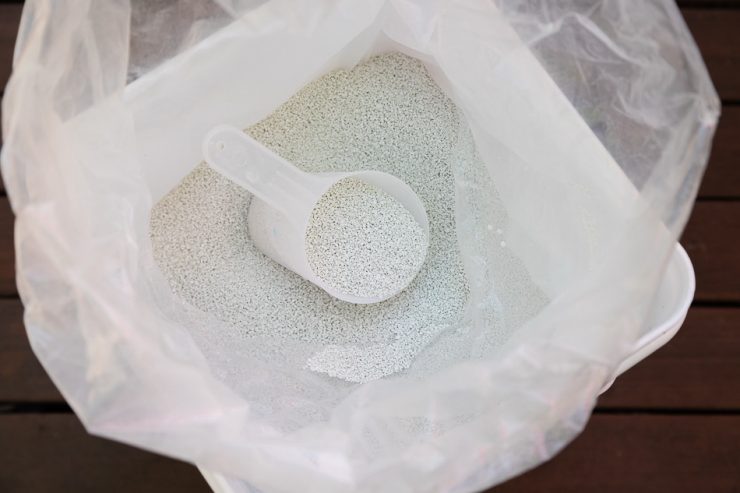
Related Reading: 5 Alternatives To Using Chlorine For Pools
Why Choose Bromine as Your Hot Tub Sanitizer?
Now let’s take a look at some of the advantages of bromine, especially in the areas of stability and health.
- Better stability in warm water
- Lasts longer
- Gentler on the skin & respiratory system
Better stability in warm water
Because bromine has a lower pH than chlorine, it’s able to balance the water chemicals more easily. This means you’ll have to spend less time testing and adjusting the sanitizer levels, and overall more time enjoying your hot tub.
It Stays Longer in Your Hot Tub
As mentioned earlier, the reason why bromine, despite its higher one-off cost, might cost the same as chlorine, in the long run, is that you won’t have to use as much of it as you would with chlorine.
Bromine stays effective longer. Because it’s not as reactive as chlorine, bromine will remain active in the water for a longer period, thus helping you reduce both effort and money.
It’s Gentler for Your Skin and Respiratory System
Unlike chlorine, bromine releases a much less pungent odor and is also not as noticeable on your skin and eyes. If you or someone you know has susceptible skin or has upper respiratory tract issues, bromine should be the way to go.
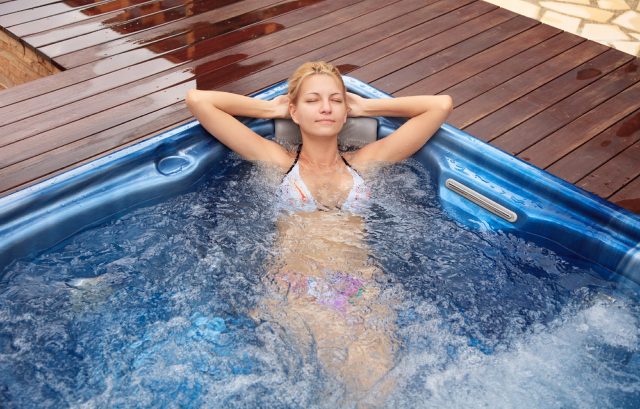
Dangers of Using Either Bromine or Chlorine
Individually, chlorine and bromine are both safe to use and don’t pose any dangers, assuming you’re using them in the proper amounts.
When mentioning specific dangers that are exclusive to one sanitizer, the only thing worth mentioning is that the excess chloramines that can remain in the humid air can cause serious breathing difficulties, including asthma attacks. If you are particularly sensitive to strong odors, it’s best to avoid using chlorine.
The real dangers that come from using these sanitizers involve the combination of the two.
In no circumstances should you ever combine them, or even place them close to one another. Mixing them in either water or granule form can result in a dangerous chemical reaction. Even storing them next to each other can be dangerous as the fumes they give off can potentially mix and become combustible gas.
Which Sanitizer is Cheaper?
As mentioned earlier, if we’re only looking at the cost per pound, then chlorine is cheaper than bromine.
For example, let’s take a look at two products (listed below) that we’ll use for a hypothetically 300-gallon (1,136 L) small/medium hot tub. Both are in granule form.
| Cost Per Dose | Cost for Per Lb | |
| Chlorine | $3.50 | $17.50 |
| Bromine | $0.21 | $120 |
Table shows approx. cost per lb of chlorine & bromine for hot tubs.
The first product is a bromine sanitizer that costs under $20 for a 16-ounce pack. After some fancy calculations that I reckon we shouldn’t go into, it was calculated that it would cost roughly $1.50 for enough bromine to sanitize a 300-gallon (1,136 L) hot tub to the recommended 5 ppm (5 ppm is for bromine only).
The second product is a chlorine sanitizer that costs a little under $35 for a 2-pound bottle. After the calculations, it was determined that it would cost roughly $0.21 for enough chlorine to fill a 300-gallon (1,136 L) hot tub to the recommended 3 ppm (3ppm is for chlorine only).
As you can see, the bromine is quite a bit more expensive than the chlorine to fill the same hot tub to their respective recommended concentrations. The cost differences here are a little extreme. When bought in bulk, bromine usually costs around twice that of chlorine.
You’ll need to dose your hot tub with bromine less often so the costs will even out a little. Overall, bromine will likely be more expensive though.
Which is Safer, Chlorine or Bromine?
When it comes to safety, bromine is the obvious choice. Though neither chlorine nor bromine can damage the hot tub itself when using the proper amounts, chlorine can nonetheless be irritating to the body. There’s also the chance of the chloramines causing a serious respiratory reaction, which doesn’t exist with bromamines.
Can You Switch to Chlorine or Bromine?
If for whatever reason, you don’t like the sanitizer you chose, you can simply switch to the other. However, you can only do this when you change your water, and you will have to empty your hot tub and flush your line before adding in the new sanitizer. Chlorine and bromine mustn’t come into contact with each other.
You’ll also need to replace your chlorine or bromine floater or tablet feeder with a new one.
Which Hot Tub Owners Should Use Chlorine?
Chlorine should be used for hot tubs that are outside in direct sunlight. It’s best for those who want to save money on their hot tub running costs.
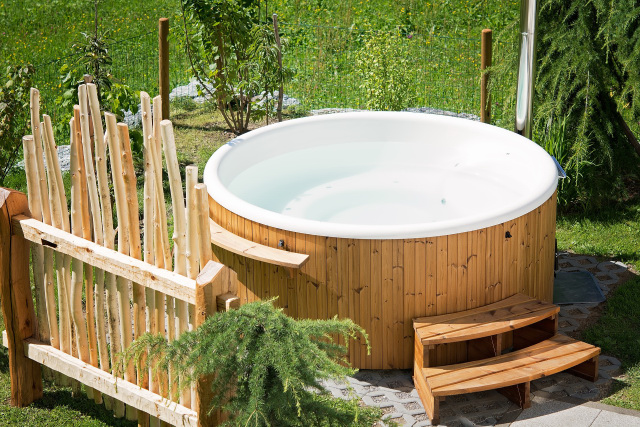
Which Hot Tub Owners Should Use Bromine?
Bromine is for those with sensitive skin or respiratory issues. You’ll need a bigger budget too. It’s also the best choice for hot tubs and spas that are indoors or in the shade.
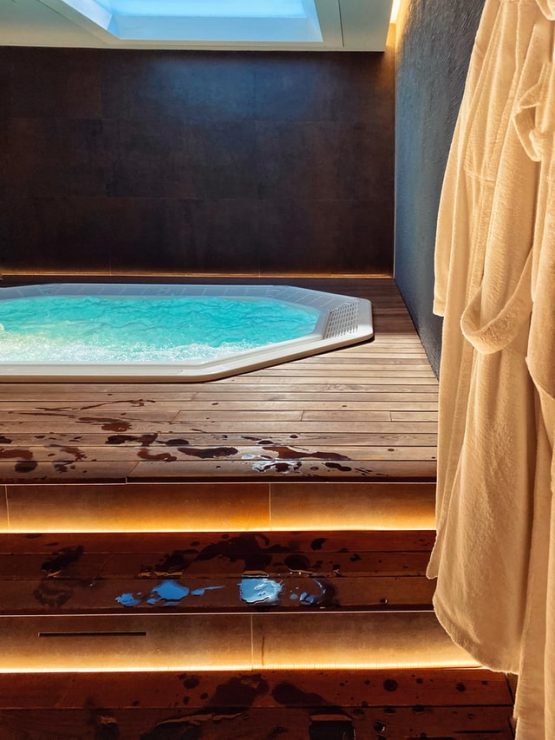
Final Thoughts
We went over a lot of information in this article, but I believe you should be aware of all the details regarding your choices when you’re deciding, especially one that involves your hot tub! In the end, although more people tend to prefer bromine over chlorine (mainly due to its safety and ease of use), it’s ultimately up to you to make the decision that best fits your needs.
Related Reading:
How Long Does It Take to Heat a Hot Tub? (and Tips for Faster Heating)
How to Shock a Hot Tub
2 Ways to Raise pH in Hot Tub (pH is Low)
Do You Need to Shock Hot Tubs?
How to Lower Hot Tub pH Naturally (Using Vinegar)
Soda Ash vs. Baking Soda for Hot Tub: Which is Better?
Bromine in Hot Tub High | How to Lower Bromine Levels



